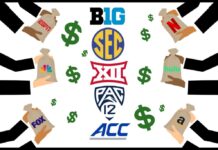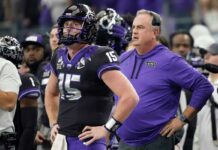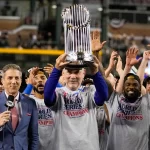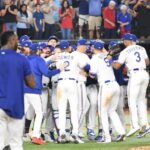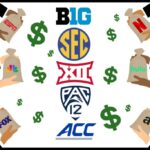On this last day of Black History Month, it seemed like a natural time to pay homage to the African American pioneers of sports. And any discussion of black history and sports has to begin with baseball, and any discussion of black athletes in baseball has to start with the Negro Leagues. Established in 1920, the Negro Leagues operated for 4 decades through baseball’s golden age. The term “league” is a little deceptive; it was more a loose alliance of independent teams than anything, but it was a thing of beauty. People of all races flocked to stadiums to watch Negro League teams like the Indianapolis Clowns and the Atlanta Black Crackers. Why? Because it was more than just baseball, it was a show. Outfielders caught fly balls with their gloves behind their backs and runners ran the base paths with reckless abandon. Trash was talked, hi-jinks were encouraged, and the crowds ate it all up.
It wasn’t all showmanship, however, the talent was there too. In baseball’s golden age of barnstorming, Negro League players regularly crossed paths with Major League legends like Dizzy Dean and the great Babe Ruth, and came out on top more often than not. There are 35 Negro League players in the Major League Baseball Hall of Fame. You know a few of the names without doubt (i.e. Willie Mays and Hank Aaron), but most of their names are lost to history. It’s impossible to discuss all the legendary figures of this bygone era, so I selected three of the true legends of the game.
Josh Gibson
Josh Gibson is widely regarded as the greatest black power hitter of all time, but he may also have simply just been the greatest slugger ever to wield a piece of pine. As most great athletes of the time, his career is shrouded in legend. The story is that he got his Negro League start in 1930 after he came out of the stands to replace an injured catcher for the Hempstead Grays. Like he just saw the catcher get hurt and said, “Don’t worry everybody, I’ve got this. Toss me a mitt.” I don’t know if you’ve ever tried playing catcher, but it’s pretty hard. At least it is for most mortals. But Josh Gibson was a different kind of athlete. He blasted homeruns out of cavernous parks with ease. Often referred to as the “Black Babe Ruth”, Gibson managed to do something the Babe never did- hit a baseball clear out of Yankee Stadium. Gibson’s career best (as far as we can tell) for home runs in a season is 84. His plaque at the Baseball Hall of Fame just says he hit “almost 800 home runs” in his 17-year career. But Gibson was far from just a power hitter. On the contrary, he posted a .426 average in his career against the Major League pitchers he faced in the barnstorming circuit. Sadly, he never got to prove himself at the highest level, as he died at the age of 35, three months before Jackie Robinson broke the color barrier.
Like he just saw the catcher get hurt and said, “Don’t worry everybody, I’ve got this. Toss me a mitt.” I don’t know if you’ve ever tried playing catcher, but it’s pretty hard. At least it is for most mortals. But Josh Gibson was a different kind of athlete. He blasted homeruns out of cavernous parks with ease. Often referred to as the “Black Babe Ruth”, Gibson managed to do something the Babe never did- hit a baseball clear out of Yankee Stadium. Gibson’s career best (as far as we can tell) for home runs in a season is 84. His plaque at the Baseball Hall of Fame just says he hit “almost 800 home runs” in his 17-year career. But Gibson was far from just a power hitter. On the contrary, he posted a .426 average in his career against the Major League pitchers he faced in the barnstorming circuit. Sadly, he never got to prove himself at the highest level, as he died at the age of 35, three months before Jackie Robinson broke the color barrier.
Satchel Paige
Leroy “Satchel” Paige is one of the greatest characters ever to walk this planet. Paige earned his nickname as a child, carrying luggage for passengers at a train station in Mobile, Alabama and it followed him his entire life. He was a string bean of man with a wit almost as quick as his fastball. Satchel Paige was the greatest gate attraction the  Negro Leagues ever had. Everyone wanted to see him pitch. He was a one-man show that transcended race, class and hometown allegiance. Paige was so talented that, as a teenager, the owners of a professional white baseball team offered him a 10-day contract as long as he was willing to paint himself a shade lighter and pretend to be Hispanic. I could write for days about Satchel Paige, but the legend of Satchel is best perpetuated in the numbers he compiled and the words he spoke. Both are impressive. Paige’s professional career spanned almost 30 years from 1924-1953, but what makes this even more astounding is the sheer quantity of innings he pitched. A real workhorse, Paige once started 29 games (a season’s worth for today’s pitchers) in the span of one month. When the Negro Leagues closed shop in the winter, he would migrate south to the Caribbean Leagues and pitch until he they resumed play in the spring.
Negro Leagues ever had. Everyone wanted to see him pitch. He was a one-man show that transcended race, class and hometown allegiance. Paige was so talented that, as a teenager, the owners of a professional white baseball team offered him a 10-day contract as long as he was willing to paint himself a shade lighter and pretend to be Hispanic. I could write for days about Satchel Paige, but the legend of Satchel is best perpetuated in the numbers he compiled and the words he spoke. Both are impressive. Paige’s professional career spanned almost 30 years from 1924-1953, but what makes this even more astounding is the sheer quantity of innings he pitched. A real workhorse, Paige once started 29 games (a season’s worth for today’s pitchers) in the span of one month. When the Negro Leagues closed shop in the winter, he would migrate south to the Caribbean Leagues and pitch until he they resumed play in the spring.
Paige had a whole array of pitches (up to as many as 30 different ones, he claimed) that he used to frustrate countless batters. When asked about the legality of his repertoire he said, “I ain’t never thrown an illegal pitch. The trouble is, every once and a while I would throw one that ain’t never been seen by this generation.” Satchel Paige didn’t make his major league debut until he was 42 years old. The legend is that Paige convinced the Cleveland Indians’ owner Bill Veeck to buy his rights after throwing four straight fastballs directly over an old, used up cigarette butt. Satchel retired in 1953 after playing six years (all after the age of 42 mind you) and posting a 3.29 ERA in the Majors. He appeared in 179 MLB games and never once was charged with an error. Paige continues to hold the record for oldest MLB rookie (42) and the oldest major leaguer period after he returned to pitch three innings for the Kansas City Athletics at the ripe old age of 59. Said Satchel, “Age is a matter of mind over matter. If you don’t mind, then it doesn’t matter.” Joe DiMaggio said he was the best and fastest pitcher he ever faced. Hundreds of others, from Bismarck, North Dakota to Santo Domingo, shared the sentiment. Satchel Paige was one of the few true legends of sport, a Paul Bunyan of the baseball diamond. No one could ever sum up the life of Satchel Paige better than he did when he said, “Ain’t no man that can avoid being born common, but there ain’t no man that got to be common.”
Jackie Robinson
I’m sure you know who Jackie Robinson was. You may have even seen the recent movie “42”, which chronicles his historic rise to the major leagues, but I can almost guarantee you that you don’t know the full Jackie Robinson story. Jack Roosevelt Robinson was born in Georgia, but spent most of his childhood in Pasadena, California. Growing up, Robinson had a fairly diverse group of friends in a neighborhood where whites, Asians and blacks mixed with regularity. When Jackie was 17-years-old, his older brother Mack won a silver medal  in the 1936 Berlin Olympics. The only person faster than Mack that day was Jesse Owens. Jackie followed in his brother’s footsteps, attending the same school, Pasadena Junior College. Soon PJC grew too small for Robinson and he took his talents to UCLA, where he became the first Bruin to letter in 4 different sports – football, baseball, basketball, and track. Baseball was actually Jackie’s 4th best sport. His strongest was football, where he played halfback and earned All-American honors in 1941. Highlights of Jackie’s gridiron days are on YouTube and they do not fail to impress.
in the 1936 Berlin Olympics. The only person faster than Mack that day was Jesse Owens. Jackie followed in his brother’s footsteps, attending the same school, Pasadena Junior College. Soon PJC grew too small for Robinson and he took his talents to UCLA, where he became the first Bruin to letter in 4 different sports – football, baseball, basketball, and track. Baseball was actually Jackie’s 4th best sport. His strongest was football, where he played halfback and earned All-American honors in 1941. Highlights of Jackie’s gridiron days are on YouTube and they do not fail to impress.
Robinson’s second best sport was probably track, where he was a national champion in the long jump. In basketball, Jackie was a fast break dunking machine. He led the Pacific Coast Conference (now the PAC-12) Southern Division in scoring twice (‘40 and ’41) and even played professionally for a team called the Los Angeles Red Devils. His collegiate baseball career was much less impressive. Jackie played one season and posted a .097 batting average before being drafted into the US military in 1942. While serving his country, he befriended heavyweight champion (and fellow trailblazing athlete) Joe Louis and rose to the rank of 2nd Lieutenant. His military career, however, came to an end after he was taken into custody by military police after refusing to sit at the back of bus that contained a white officer’s wife. Jackie was court-martialed for his insubordination, but the charges were eventually dropped and he wound up being honorably discharged. Lucky for all of us, this is when Jackie turned to baseball (well, after he served as a collegiate athletic director for a year and….never mind, it’s a long story).
Jackie Robinson played for only one year in the Negro Leagues for the Kansas City Monarchs. Kansas City was the Negro League equivalent of the New York Yankees. In 40 years of operation, they won 27 championships. When you win, people come to watch you, and it was at this time Jackie caught the attention of Branch Rickey. Branch Rickey was the general manager of the Brooklyn Dodgers and a life long antagonist to the status quo. There were far superior baseball talents in the Negro Leagues at the time, but Rickey picked Jackie because of his upbringing, college education and a gut feeling. Jackie broke the color barrier in 1947, winning the first ever MLB Rookie of the Year Award while playing out of position at first base. Once Jackie entered the league, it opened up the floodgates for other black ballplayers. Months after his arrival, the Indians integrated the American League with the signings of Larry Doby and Satchel Paige. Forward thinking baseball teams scoured the Negro Leagues looking for talent previously unwelcomed. It was during this gold rush, that teams discovered future Hall-of-Famers Hank Aaron and Willie Mays. In 1949, Robinson won the MVP playing second base, and by then, he was no longer the only black player on the Dodgers. In fact, he probably wasn’t even the best black player on the Dodgers, with that distinction most likely belonging to future 3-time MVP Roy Campenella. But he was solid in the field, above average at the plate (career .311 batting average), and an absolute force on the base paths where he ran like a man possessed. His signature was stealing home plate, an uncanny ability he displayed until his retirement. When it comes to talent and numbers, there are whole fleets of players who rank ahead of Jackie Robinson, but his character and accomplishments place his name among the all time greats in any sport.




